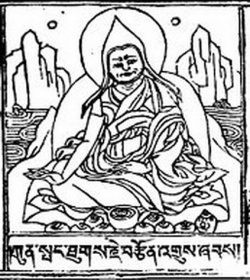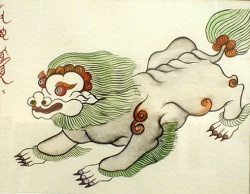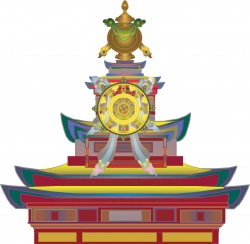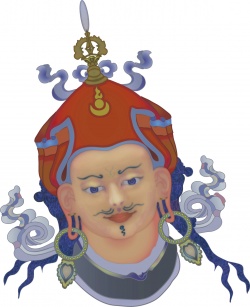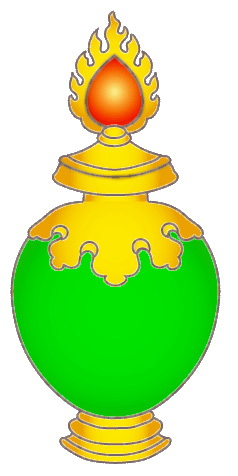Difference between revisions of "Kunpang Tukje Tsondru"
| Line 16: | Line 16: | ||
While the [[Gelugpa]] embraced the [[Jonang]] [[teaching]] on the [[Kalachakra]], they ultimately opposed the [[Jonangpa]] (followers of the [[Jonang]]) over a difference in [[philosophical]] [[view]]. [[Yumo Mikyo Dorje]], [[Dolpopa Sherab Gyeltsen]] and subsequent [[lamas]] maintained a [[teaching]] known as [[zhentong]], which holds that only the clear-light, [[non-dual]] [[nature]] of the [[mind]] is "real", and everything else is [[empty of inherent existence]]. The [[Gelug school]] held the {{Wiki|distinct}} but related [[rangtong]] [[view]] that all [[phenomena]] are [[empty]] (of [[inherent]] [[existence]]) and no thing or process (including [[Mind]] and its qualities) may be asserted as {{Wiki|independent}} or inherently real (neither may [[phenomena]] be asserted as "unreal" - in short, both extreme assertions are seen to be groundless, and the [[middle way]] that [[phenomena]] are non-inherently real is asserted). For more [[information]] on the [[subject]] of [[emptiness]] in [[Buddhism]], see nyat . | While the [[Gelugpa]] embraced the [[Jonang]] [[teaching]] on the [[Kalachakra]], they ultimately opposed the [[Jonangpa]] (followers of the [[Jonang]]) over a difference in [[philosophical]] [[view]]. [[Yumo Mikyo Dorje]], [[Dolpopa Sherab Gyeltsen]] and subsequent [[lamas]] maintained a [[teaching]] known as [[zhentong]], which holds that only the clear-light, [[non-dual]] [[nature]] of the [[mind]] is "real", and everything else is [[empty of inherent existence]]. The [[Gelug school]] held the {{Wiki|distinct}} but related [[rangtong]] [[view]] that all [[phenomena]] are [[empty]] (of [[inherent]] [[existence]]) and no thing or process (including [[Mind]] and its qualities) may be asserted as {{Wiki|independent}} or inherently real (neither may [[phenomena]] be asserted as "unreal" - in short, both extreme assertions are seen to be groundless, and the [[middle way]] that [[phenomena]] are non-inherently real is asserted). For more [[information]] on the [[subject]] of [[emptiness]] in [[Buddhism]], see nyat . | ||
| − | For the Jonangpas,the [[emptiness]] of [[ultimate reality]] should not be characterized in the same way as the [[emptiness]] of apparent [[phenomena]] because it is prabh svara-sa t na, or "[[clear light]] [[mental]] {{Wiki|continuum}}," endowed with limitless [[Buddha]] qualities. | + | For the Jonangpas,the [[emptiness]] of [[ultimate reality]] should not be characterized in the same way as the [[emptiness]] of apparent [[phenomena]] because it is prabh svara-sa t na, or "[[clear light]] [[mental]] {{Wiki|continuum}}," endowed with limitless [[Buddha]] qualities. It is [[empty]] of all that is false, not [[empty]] of the limitless [[Buddha]] qualities that are its [[innate nature]]. |
{{Wiki|Political}} [[reasons]] for suppression of the [[Jonangpa]] | {{Wiki|Political}} [[reasons]] for suppression of the [[Jonangpa]] | ||
[[File:DharmaRatas-Tempel-3.jpg|thumb|250px|]] | [[File:DharmaRatas-Tempel-3.jpg|thumb|250px|]] | ||
| Line 38: | Line 38: | ||
The [[Jonang tradition]] has recently officially registered with the {{Wiki|Tibetan Government in exile}} to be [[recognized]] as the fifth living [[Buddhist tradition]] of [[Tibetan Buddhism]]. The [[14th Dalai Lama]] assigned [[Khalkha Jetsun Dampa]] [[Rinpoche]] or the '[[Bogd Gegeen]]' of [[Mongolia]] (who is considered to be an [[incarnation]] of [[Taranatha]]) as the leader of the [[Jonang tradition]]. | The [[Jonang tradition]] has recently officially registered with the {{Wiki|Tibetan Government in exile}} to be [[recognized]] as the fifth living [[Buddhist tradition]] of [[Tibetan Buddhism]]. The [[14th Dalai Lama]] assigned [[Khalkha Jetsun Dampa]] [[Rinpoche]] or the '[[Bogd Gegeen]]' of [[Mongolia]] (who is considered to be an [[incarnation]] of [[Taranatha]]) as the leader of the [[Jonang tradition]]. | ||
| − | Much of the {{Wiki|literature}} of the [[Jonang]] has also survived, including the [[Treatise on Other-Emptiness]] and the [[Buddha-Matrix]] by D l-bo-ba ay-rap-gyen-tsen, consisting of arguments (all supported by quotations taken from the generally-accepted {{Wiki|orthodox}} [[Wikipedia:canonical|canonical]] Vaip lya S tra-s) against "[[self-emptiness]]" and in favor of "[[other-emptiness]]", which has been published in English translation under the title [[Mountain Doctrine]]. | + | Much of the {{Wiki|literature}} of the [[Jonang]] has also survived, including the [[Treatise on Other-Emptiness]] and the [[Buddha-Matrix]] by [[D l-bo-ba ay-rap-gyen-tsen]], consisting of arguments (all supported by quotations taken from the generally-accepted {{Wiki|orthodox}} [[Wikipedia:canonical|canonical]] Vaip lya S tra-s) against "[[self-emptiness]]" and in favor of "[[other-emptiness]]", which has been published in English translation under the title [[Mountain Doctrine]]. |
Notes | Notes | ||
Revision as of 18:28, 7 April 2014
The Jonang ( ; Chinese: ) is one of the schools of Tibetan Buddhism. Its origins in Tibet can be traced to early 12th century master Yumo Mikyo Dorje, but became much wider known with the help of Dolpopa Sherab Gyeltsen, a monk originally trained in the Sakya school. The Jonang school was widely thought to have become extinct in the late 17th century at the hands of the Fifth Dalai Lama who forcibly annexed the Jonang monasteries to his Gelug school, declaring them heretical. Recently, however, it was discovered that some remote Jonang monasteries escaped this fate and have continued practicing uninterrupted to this day. According to Gruschke, an estimated 5,000 monks and nuns of the Jonang tradition practice today in areas at the edge of historic Gelug influence.
History
In 1294, the monk Kunpang Tukje Tsondru established the Puntsok Choling monastery at Jomonang, about 160 km northwest of the Tashilhunpo Monastery in -Tsang (Shigatse), and the spiritual tradition that was established here became known as Jonang.
The Jonang tradition combines two specific teachings, what has come to be known as the zhentong (or shentong) philosophy of emptiness, and the Dro-lineage of the Kalachakra tantra. The origin of this combination in Tibet is traced to the master Yumo Mikyo Dorje - an 11th/12th century pupil of the Kashmiri master Somanatha.
After several centuries of independence, however, in the late 17th century the Jonang order came under attack by the Fifth Dalai Lama who converted their monasteries to the Gelug order.
The Jonang school has generated a number of renowned Buddhist scholars, like Dolpopa Sherab Gyeltsen (1292 1361),[1] but the most famous was Jetsun Taranatha (1575 1634). Taranatha placed great emphasis on the Kalachakra system of tantra. After the Jonang monasteries were forcibly converted to the Gelug lineage, their Kalachakra teachings were absorbed into the Gelug school. Taranatha's influence on Gelugpa thinking continues even to this day in the teaching of the present 14th Dalai Lama, who actively promotes initiation into Kalachakra.
Doctrinal/Philosophical reasons for suppression of the Jonangpa
While the Gelugpa embraced the Jonang teaching on the Kalachakra, they ultimately opposed the Jonangpa (followers of the Jonang) over a difference in philosophical view. Yumo Mikyo Dorje, Dolpopa Sherab Gyeltsen and subsequent lamas maintained a teaching known as zhentong, which holds that only the clear-light, non-dual nature of the mind is "real", and everything else is empty of inherent existence. The Gelug school held the distinct but related rangtong view that all phenomena are empty (of inherent existence) and no thing or process (including Mind and its qualities) may be asserted as independent or inherently real (neither may phenomena be asserted as "unreal" - in short, both extreme assertions are seen to be groundless, and the middle way that phenomena are non-inherently real is asserted). For more information on the subject of emptiness in Buddhism, see nyat .
For the Jonangpas,the emptiness of ultimate reality should not be characterized in the same way as the emptiness of apparent phenomena because it is prabh svara-sa t na, or "clear light mental continuum," endowed with limitless Buddha qualities. It is empty of all that is false, not empty of the limitless Buddha qualities that are its innate nature.
Political reasons for suppression of the Jonangpa
Modern historians have identified two other reasons which more likely led the Gelugpa to suppress the Jonangpa. First, the Jonangpa had political ties that were very vexing to the Gelugpa. The Jonangpa, along with the Kagyupa, were historical allies with the powerful house of Tsang, which was vying with the Dalai Lama and the Gelug school for control of central Tibet. This was bad enough, but soon after the death of Taranatha an even more ominous event occurred. Taranatha's reincarnation was discovered to be a young boy named Zanabazar the son of Prince T sheet Khan, ruler of Central Khalkha. T sheet Khan and his son were of Borjigin lineage (imperial clan of Genghis Khan and his successors), meaning they had the birth authority to become Khan. When the young boy was declared the spiritual leader of all of Mongolia, suddenly the Gelugpa were faced with the possibility of war with the former military superpower of Asia. While the Mongol Empire was long past its zenith, this was nonetheless a frightening prospect and the Dalai Lama sought the first possible moment of Mongol distraction to take control of the Jonangpa monasteries.
The 14th Dalai Lama confirmed this view in Glenn Mullin's The Fourteen Dalai Lamas (Clear Light Publishers, p. 207):
"These monasteries were closed for political reasons, not religious ones, and their closing had nothing to do with sectarianism. They had supported the Tsangpa king in the uprising, thus committing treason. The Great Fifth believed that they should be closed in order to insure the future stability of the (Tibetan) nation, and to dissuade other monasteries from engaging in warfare."
He continued,
"The fact is that the Great Fifth passed laws outlawing sectarian skirmishes, and passed laws ensuring the freedom of religion. This freedom was extended to not only the Buddhist schools, but also to the non-Buddhist ones. For example, he kept a Bonpo lama in his entourage to speak for the interests of the Bon movement. And on a personal level, he himself practiced so many non-Gelukpa lineages that the Gelukpas criticized him for straying from his roots."
However, in The Buddha from Dolpo: A Study of the Life and Thought of the Tibetan Master Dolpopa Sherab Gyaltsen, scholar Cyrus Stearns details that the writings of Dolpopa Sherab Gyaltsen (1292 1361) and even those of Sakya proponents of zhentong were sealed and banned from publication and study, and that the Jonang monks and nuns forcibly were converted to the Gelug lineage.
Rediscovery
The Jonangpa were until recently thought to be an extinct heretical sect. Thus, Tibetologists were astonished when fieldwork turned up several active Jonangpa monasteries, including the main monastery called Tsangwa located in Tibet, Dzamthang County. Almost 40 monasteries, comprising about 5,000 monks, have subsequently been found, including some in the Amdo and Gyarong districts of Qinghai and the Tibet Autonomous Region.[3]
Interestingly, one of the primary supporters of the Jonang lineage in exile has been the 14th Dalai Lama of the Gelugpa lineage. The Dalai Lama donated buildings in Himachal Pradesh state in Shimla, India for use as a Jonang monastery (now known as the Main Takten Phuntsok Choeling Monastery) and has visited during one of his recent teaching tours. The Karmapa of the Karma Kagyu lineage has also visited there.
The Jonang tradition has recently officially registered with the Tibetan Government in exile to be recognized as the fifth living Buddhist tradition of Tibetan Buddhism. The 14th Dalai Lama assigned Khalkha Jetsun Dampa Rinpoche or the 'Bogd Gegeen' of Mongolia (who is considered to be an incarnation of Taranatha) as the leader of the Jonang tradition.
Much of the literature of the Jonang has also survived, including the Treatise on Other-Emptiness and the Buddha-Matrix by D l-bo-ba ay-rap-gyen-tsen, consisting of arguments (all supported by quotations taken from the generally-accepted orthodox canonical Vaip lya S tra-s) against "self-emptiness" and in favor of "other-emptiness", which has been published in English translation under the title Mountain Doctrine.
Notes
↑ Newland, Guy (1992). The Two Truths: in the M dhyamika Philosophy of the Ge-luk-ba Order of Tibetan Buddhism. Ithaca, New York, USA: Snow Lion Publications. ISBN 0-937938-79-3. p.29
↑ Lama Shenpen, Emptiness Teachings. Buddhism Connect (accessed March, 2010)
↑ Gruschke 2001, p.72; and A. Gruschke, "Der Jonang-Orden: Gr nde f r seinen Niedergang, Voraussetzungen f r das berdauern und aktuelle Lage", in: Henk Blezer (ed.), Tibet, Past and Present. Tibetan Studies I (Proceedings of the Ninth Seminar of The IATS, 2000), Brill Academic Publishers, Leiden 2002, pp. 183-214
References
Mullin, G. The Fourteen Dalai Lamas: A Sacred Legacy of Reincarnation. ISBN 1-57416-039-7.
Gruschke, A. (2000). The Jonangpa Order - Causes for the downfall, conditions of the survival and current situation of a presumably extinct Tibetan-Buddhist School. Ninth Seminar of The International Association for Tibetan Studies
Gruschke, Andreas (2001): "Monasteries of the forgotten Jonangpa". In: The Cultural Monuments of Tibet s Outer Provinces: Amdo, vol. 2, White Lotus Press, Bangkok 2001, pp. 71 80. ISBN 974-7534-90-8
Stearns, Cyrus (1999). The Buddha from Dolpo: A Study of the Life and Thought of the Tibetan Master Dolpopa Sherab Gyaltsen. State University of New York Press. ISBN 0-7914-4191-1 (hc); ISBN 0-7914-4192-X (pbk)
Jeffrey Hopkins (translator); Kevin Vose (editor) : Mountain Doctrine. Snow Lion, Ithaca, 2006.
